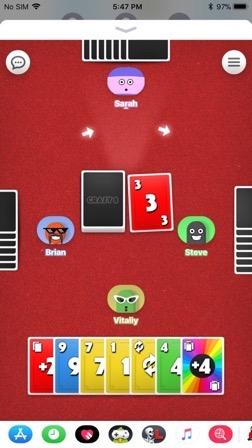Prompt: “How does the game compare and contrast with your team’s concept?”
The game I chose for my critical play was the Crazy-8 card game found on iMessage’s Game Pigeon extension also known as Uno. I wanted to wait until I had done a test play of my team’s game prototype before choosing a fittingly accurate game to critically analyze. From my play of both my team’s card game Tiger Mom and Crazy-8, I was able to glean a lot of similarities. To start, Crazy-8 is a card game in which Additionally, I understand the target audience of Crazy-8 to be the same as our Tiger Mom game: teens and college-aged adults.
I found it interesting that in Crazy-8 there is no ability to trade cards or come to learn the hand of your opponents, and you can only effect the player directly to your left (or right depending on if the reverse card is played). In order to encourage interaction between players however, Tiger Mom gives players the option to play an “action card” on any other player in the game or trade resources with other moms by offering an exchange during their turn which all of the other moms can jump in to accept. While these are vastly different mechanics, I found that both games allow dynamics in which players will form short term fellowships of allyships and opposition. For example in Crazy-8, when I was hit with a +2 card by the player to my right, I instantly begged the other players to put down a reverse direction card so that I could retaliate upon them with a +4 card. In this instance, I formed a rivalry/hatred of the player who had interacted with me. However when another player communicated that the person to my left was observed to have only 2 cards, I revealed that I had another +4 card and the reporter placed another reverse card so that I could prevent them from winning. Here, myself and another player formed an allyship against another player in order to prevent them from winning the game, so that both of us could continue to progress. In similar dynamics, while playing Tiger Mom, I traded twice with a teammate, but after I hit them with a “discard 1” card, they refused to trade with me afterwards as an act of opposition.
Another differing mechanic is that in Crazy-8 you are able to gain infinitely many cards throughout the game, whereas in Tiger Mom you are limited to at most 6 cards, and must chose a card to discard after gaining any additional cards. This is due to a fundamental difference in the games’ goals in which for Crazy-8 your goal is to have as few cards as possible, making it advantageous to be able to sabatogue opponents with additional cards. Tiger Mom on the other hand is won by procuring certain resources, so keeping useless cards would do nothing for any of the players but hoard unnecessary resources. Thus we capped the card count to eliminate players stalling at each turn. Parallel to this, is the fact that in Crazy-8, all players have the same goal and therefore know the goal of every other player: to get down to 0 cards. In Tiger Mom, however, each player needs to get a different combination of resources in order to win, denoted by the identity of their children. As a result, there is an intuition that Crazy-8 gives its players that the closest to winning is the player with the least cards, which is removed in Tiger Mom. I think this changes the result of the game because while players can attack any other player who may or may not be in the lead, it may be much harder to tell which players are close to winning, and band against them. The dynamic of multiple players allying against others seems unsupported in Tiger Moms. Yet, in one example, when one of the players cast a card which negatively effected all other players, we all retaliated against her so perhaps the same dynamic is recreated in Tiger Moms after all.
One last difference I would like to touch upon is that while Crazy-8 assigns no roles to its players, Tiger Mom gives each player the role of mother to a different child and constructs a narrative for them as an overinvolved mom who wants their child to prove supremacy over rival moms’ children. This introduces an aesthetic of narrative fun in which players are enveloped in a narrative which they begin to control through their game play. Overall I really enjoyed playing both games!




